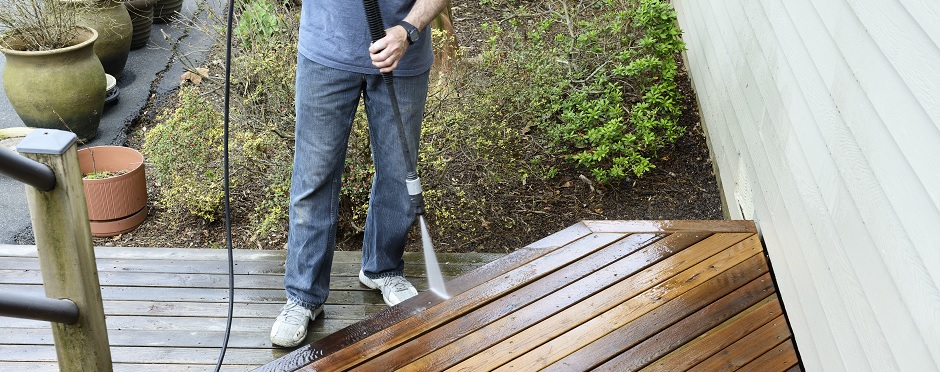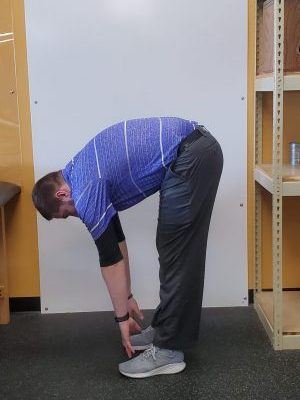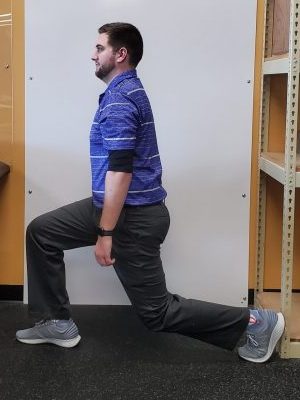
Spring Cleaning: Tips to Stay Injury-Free
Leave a CommentAs the weather begins to warm up, many of us are starting to think about ways to spruce up the outside of our homes and do some spring cleaning on the inside. This increase in manual labor after months of winter isolation can lead to aches and pains. Here are a few tips to avoid pain and extra stress on your body as you start your spring clean-up in and outside of your home.
- Warm up-a brisk walk around the block. This will get your blood circulating and warm your muscles to prepare them for work. Some dynamic stretches before and after activity to the back, legs, and arms, will help prepare the body and prevent injury. Arm and shoulder circles, high knees, toe touches or reaching towards the ground, and a few walking lunges may help prevent muscle strains and prepare your body for work.
 Clinician performing toe touch |
 Clinician performing walking lunge |
- Stay hydrated. This will allow your muscles to work more efficiently, prevent injury, and overheating. Staying hydrated can also prevent some soreness from occurring the following day.
- Engage your abdominals when lifting, raking, shoveling, or vacuuming. This will allow your core muscles to support your back when performing strenuous tasks. When lifting and carrying bags of mulch, fertilizer or grass clippings, engage your core and bend at the knees when lifting.
- Maintain good upright posture. When vacuuming or mowing, move your feet instead of using your arms to do the work. Keep the mower, mop or vacuum at waist level, and instead of bending forward and stretching out your arms, walk forward and back to allow the tool to do your work and not your back and arms.
- Avoid overuse. When washing windows, mirrors, and walls, avoid overuse with the dominant arm by alternating use of both arms. When using a leaf blower, turn your trunk and legs to turn the blower instead of using your forearm. This allows you to use you larger back and leg muscles to prevent overuse of your small muscles in the forearm.
Correct tool use is key whether working inside or outside. Here are a couple of suggestions to allow you to pick the correct tools for your spring cleaning:
- When completing chores inside, consider using long-handled cleaning tools to clean things like the tub and shower so you can do the job while keeping your body upright with your back in a relaxed, neutral spine.
- When planting or weeding outside, use a pad to protect your knees. You can also use a stool if it is painful to kneel. Many commercial products are available that combine the functionality of both of these products, a kneeler seat that is a combination of a padded platform that can be turned upside down to then sit on as well.
- Consider using a stand up weed puller. This device will allow you to stand upright, while it grasps the weed. It can hold on to the weed until you release it in a receptacle. This avoids repetitive bending or working from a stooped over position.
- Make sure that your hand held garden tools have large handles that are soft and easy to hold on to in order to decrease stress on your fingers. Longer tools can help to create more leverage.
- Make certain that loppers, hedge trimmers and pruners are sharp and well-oiled to allow them to move easily to avoid excess stress and pressure. Tools should have ratcheting or spring-action/self-opening features to save your hands and arms from excessive forces. There are many videos available online to educate yourself in how to safely sharpen your tools, should they become dull.
- Avoid repetitive lifting and carrying by using a wheeled cart or a wheel barrow when transporting bags of mulch or top soil. If the large bags of mulch and dirt are too heavy for you to safely lift, divide them into smaller loads. Consider hiring help to assist with the heavier, strenuous tasks.
- Avoid working overhead if possible. Instead, use a stable step ladder or ladder to raise your body so that your work is chest level and not overhead.
- Remember throughout all your work to take rest breaks often and to vary the types of tasks between strenuous and lighter tasks. Stretch when your jobs are complete and consider icing any areas that are achy. A warm bath can help to relieve muscle strain after a hard day’s work. Don’t forget to admire all of the hard work you have done as you turn your house into a home!
If you’re experiencing aches and pains that are getting in the way of your spring cleaning, reach out to your nearest Athletico for a free assessment. Free assessments are available both in-clinic and virtually through our telehealth platform.
The Athletico blog is an educational resource written by Athletico employees. Athletico bloggers are licensed professionals who abide by the code of ethics outlined by their respective professional associations. The content published in blog posts represents the opinion of the individual author based on their expertise and experience. The content provided in this blog is for informational purposes only, does not constitute medical advice and should not be relied on for making personal health decisions.
References:
1. Morrison, B., (2019) Pain Free Gardning and Yard Work. Retrived from https://bodygears.com/pain-free-gardening-yard-work/
2. (2011) The Ergonomic Gardener-Humantech, Ergonomic Gardening Tips. Retrieved from https://www.humantech.com/the-ergonomic-gardener/
3. Au, K., (2016) 5 Back-Saving Tips for Spring Cleaning. Retrived from https://lawrenceparkhealth.com/6-spring-snacks/
4. Wagenfeld, A., Buresh, G., (2019) Healthy Gardening, American Occupational Therapy Association Retrieved from https://www.aota.org/About-Occupational-Therapy/Patients-Clients/Adults/gardening.aspx
